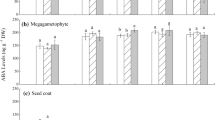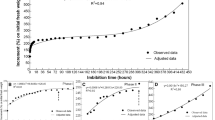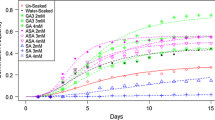Abstract
Spondias pinnata (L. f.) Kurz., belonging to the family Anacardiaceae, is an ethnobotanically important deciduous tree species facing difficulties in their natural regeneration. The germination rate and percentage of this species is reported to be very low. The freshly fallen ‘stones’ (seeds covered by endocarp) are observed to germinate only after a period of after-ripening. The present investigation was focused on the change in endogenous phytohormonal flux when the fallen seeds were hydrated to induce germination. A comparison was made with non-dormant seeds of Vigna unguiculata (L.) Walp. (var. sesquipedalis) to understand the nature of dormancy in S. pinnata. Germination tests were conducted, and the embryo moisture content during seed shed and seed hydration for both the species were determined. Phytohormonal analysis of fourteen plant growth regulators (PGRs) was carried out using LC–MS/MS. The embryo moisture content in S. pinnata was above 20%, but no germination was observed even up to a period of 1 month under ambient conditions, where the seeds of V. unguiculata with 10% moisture content sprout out after two days of hydration. The LC–MS/MS data showed elevated level of abscisic acid (ABA) in S. pinnata seeds (70.971 ± 0.707 ng g dry weight−1) in comparison with V. unguiculata (7.75 ± 0.08 ng g dry weight−1) on hydration indicating the onset of physiological dormancy. The germination promoting PGRs, viz. gibberellins (GA), indole-3-acetic acid (IAA) and trans-zeatin (tZ) were found to upregulate significantly in V. unguiculata seeds on hydration but not in S. pinnata seeds explaining their dormancy.






Similar content being viewed by others
Data availability
The data that support this study cannot be publicly shared due to privacy reasons and may be shared upon reasonable request to the corresponding author if appropriate.
References
Alonso-Ramírez A, Rodríguez D, Reyes D, Jiménez JA, Nicolás G, López-Climent M, Gómez-Cadenas A, Nicolás C (2009) Evidence for a role of gibberellins in salicylic acid-modulated early plant responses to abiotic stress in Arabidopsis seeds. Plant Physiol 150:1335–1344
Badoni A, Bisht C (2009) Importance and problems in natural regeneration of Spondias pinnata. Rep Opinion 1:12–13
Bajguz A, Tretyn A (2003) The chemical characteristic and distribution of brassinosteroids in plants. Phytochemistry 62:1027–1046
Baskin CC, Baskin JM (1998) Seeds: ecology, biogeography, and evolution of dormancy and germination. Lexington, Kentucky
Baskin JM, Baskin CC (2004) A classification system for seed dormancy. Seed Sci Res 14:1–16
Baskin CC, Baskin JM (2005) Seed dormancy in trees of climax tropical vegetation types. Trop Ecol 46:17–28
Bewley JD (1997) Seed germination and dormancy. Plant Cell 9:1055
Calvo AP, Nicolás C, Lorenzo O, Nicolás G, Rodríguez D (2004) Evidence for positive regulation by gibberellins and ethylene of ACC oxidase expression and activity during transition from dormancy to germination in Fagus sylvatica L. seeds. J Plant Growth Regul 23:44–53
Cao S, Xu Q, Cao Y, Qian K, An K, Zhu Y, Binzeng H, Zhao H, Kuai B (2005) Loss-of-function mutations in DET2 gene lead to an enhanced resistance to oxidative stress in Arabidopsis. Physiol Plant 123:57–66
Carvalho ND, Nakagawa J (2012) Seeds: science, technology and production. Jaboticabal: Funep 590
Chen SY, Chien CT, Baskin JM, Baskin CC (2010) Storage behavior and changes in concentrations of abscisic acid and gibberellins during dormancy break and germination in seeds of Phellodendron amurense var wilsonii (Rutaceae). Tree Physiol 30:275–284
Chibani K, Ali-Rachedi S, Job C, Job D, Jullien M, Grappin P (2006) Proteomic analysis of seed dormancy in Arabidopsis. Plant Physiol 142:1493–1510
Chiwocha SD, Cutler AJ, Abrams SR, Ambrose SJ, Yang J, Ross AR, Kermode AR (2005) The etr1-2 mutation in Arabidopsis thaliana affects the abscisic acid, auxin, cytokinin and gibberellin metabolic pathways during maintenance of seed dormancy, moist-chilling and germination. Plant J 42:35–48
Dave A, Hernández ML, He Z, Andriotis VM, Vaistij FE, Larson TR, Graham IA (2011) 12-Oxo-phytodienoic acid accumulation during seed development represses seed germination in Arabidopsis. Plant Cell 23:583–599
de Oliveira CAC, Alves R (2021) Problems concerning dormancy and its investigation in hog plum (Spondias mombin Linn.): a review. Embrapa Amazônia Oriental-Artigo em anais de congresso (ALICE) CONGRESSO INTERNACIONAL DAS CIÊNCIAS AGRÁRIAS 5 http://www.alice.cnptia.embrapa.br/alice/handle/doc/1136024
Dewar J, Taylor JRN, Berjak P (1998) Changes in selected plant growth regulators during germination in sorghum. Seed Sci Res 8:1–8
Finch-Savage WE, Leubner-Metzger G (2006) Seed dormancy and the control of germination. New Phytol 171:501–523
Finkelstein R, Reeves W, Ariizumi T, Steber C (2008) Molecular aspects of seed dormancy. Annu Rev Plant Biol 59:387–415
Finkelstein RR (2010) The role of hormones during seed development and germination. In: Plant hormones. Springer, Dordrecht, pp 549–573
Frey A, Audran C, Marin E, Sotta B, Marion-Poll A (1999) Engineering seed dormancy by the modification of zeaxanthin epoxidase gene expression. Plant Mol Biol 39:1267–1274
Fu X, Harberd NP (2003) Auxin promotes Arabidopsis root growth by modulating gibberellin response. Nature 421:740–743
Fujioka S, Sakurai A (1997) Biosynthesis and metabolism of brassinosteroids. Physiol Plant 100:710–715
García-Andrade J, Ramírez V, Flors V, Vera P (2011) Arabidopsis ocp3 mutant reveals a mechanism linking ABA and JA to pathogen-induced callose deposition. Plant J 67:783–794
Gómez-Jiménez MDC, García-Olivares E, Matilla AJ (2001) 1-Aminocyclopropane-1-carboxylate oxidase from embryonic axes of germinating chick-pea (Cicer arietinum L.) seeds: cellular immunolocalization and alterations in its expression by indole-3-acetic acid, abscisic acid and spermine. Seed Sci Res 11:243–253
Gonai T, Kawahara S, Tougou M, Satoh S, Hashiba T, Hirai N, Kawaide H, Kamiya Y, Yoshioka T (2004) Abscisic acid in the thermoinhibition of lettuce seed germination and enhancement of its catabolism by gibberellin. J Exp Bot 55:111–118
Grappin P, Bouinot D, Sotta B, Miginiac E, Jullien M (2000) Control of seed dormancy in Nicotiana plumbaginifolia: post-imbibition abscisic acid synthesis imposes dormancy maintenance. Planta 210:279–285
Groot SP, Karssen CM (1992) Dormancy and germination of abscisic acid-deficient tomato seeds: studies with the sitiens mutant. Plant Physiol 99:952–958
Gubler F, Hughes T, Waterhouse P, Jacobsen J (2008) Regulation of dormancy in barley by blue light and after-ripening: effects on abscisic acid and gibberellin metabolism. Plant Physiol 147:886–896
Gutierrez L, Bussell JD, Pacurar DI, Schwambach J, Pacurar M, Bellini C (2009) Phenotypic plasticity of adventitious rooting in Arabidopsis is controlled by complex regulation of AUXIN RESPONSE FACTOR transcripts and microRNA abundance. Plant Cell 21:3119–3132
Harper JL (1967) A Darwinian approach to plant ecology. J Appl Ecol 4:267–290
Hilhorst HW, Downie B (1996) Primary dormancy in tomato (Lycopersicon esculentum cv. Moneymaker): studies with the sitiens mutant. J Exp Bot 47:89–97
Hou D (1978) Anacardiaceae. In: Van Steenis CGGJ (eds) Flora Malesiana ser. 1, vol. 8. Alphen aan den Rijn: Sijthoff & Noordhoff 395–548
ISTA (2008) International Rules for Seed Testing, Edition 2008. International Seed Testing Association (ISTA), Bassersdorf, CH-Switzerland
Kangilal UN, Das PC (1984) Flora of Assam. Government of Assam
Khripach V, Zhabinskii V, de Groot A (2000) Twenty years of brassinosteroids: steroidal plant hormones warrant better crops for the XXI century. Ann Bot 86:441–447
Kidd M (2021) Seed dormancy breaking of temperate region deciduous tree species (Doctoral dissertation, Lancaster University (United Kingdom))
Kirtikar KR, Basu BD (1975) Indian medicinal plants Vol 1. Bishen Singh Mahendra Pal Singh Delhi 3:1899–1902
Koornneef M, Bentsink L, Hilhorst H (2002) Seed dormancy and germination. Curr Opin Plant Biol 5:33–36
Koornneef M, Karssen CM (1994) Seed dormancy and germination. In: Arabidopsis Cold Spring Harbor Laboratory Press, pp 313–334
Kostermans AJG (1991) Kedondong, Ambarella, Amra: The Spondiadeae (Anacardiaceae) in Asia and the Pacific Area (Vol. 1). Bogor: Herbarium Bogoriense
Kucera B, Cohn MA, Leubner-Metzger G (2005) Plant hormone interactions during seed dormancy release and germination. Seed Sci Res 15:281–307
Leon-Reyes A, Du Y, Koornneef A, Proietti S, Körbes AP, Memelink J, Pieterse CM, Ritsema T (2010) Ethylene signalling renders the jasmonate response of Arabidopsis insensitive to future suppression by salicylic acid. Mol Plant Microbe Interact 23:187–197
Linkies A, Müller K et al (2009) Ethylene interacts with abscisic acid to regulate endosperm rupture during germination: a comparative approach using Lepidium sativum and Arabidopsis thaliana. Plant Cell 21:3803–3822
Liu PP, Koizuka N, Homrichhausen TM, Hewitt JR, Martin RC, Nonogaki H (2005) Large-scale screening of Arabidopsis enhancer-trap lines for seed germination-associated genes. Plant J 41:936–944
Liu Z, Zhang S, Sun N, Liu H, Zhao Y, Liang Y, Zhang L, Han Y (2015) Functional diversity of jasmonates in rice. Rice 8:1–13
Lopes PSN, Magalhães HM, Gomes JG, Brandão Júnior DDS, Araújo VDD (2009) Overcoming dormancy of “umbuzeiro” seeds (Spondias tuberosa, Arr. Câm.) by using different methods. Rev Bras Frutic 31:872–880
Manz B, Muller K, Kucera B, Volke F, Leubner-Metzger G (2005) Water uptake and distribution in germinating tobacco seeds investigated in vivo by nuclear magnetic resonance imaging. Plant Physiol 138:1538–1551
Martins CC, Silva GZD, Durigan LD, Vieira RD (2019) Pregerminative treatments of yellow mombin (Spondias mombin L.) seeds. Ciência Florestal 29:363–370
Matilla AJ (2000) Ethylene in seed formation and germination. Seed Sci Res 10:111–126
Matilla AJ, Matilla-Vázquez MA (2008) Involvement of ethylene in seed physiology. Plant Sci 175:87–97
Miransari M, Smith DL (2014) Plant hormones and seed germination. Environ Exp Bot 99:110–121
Mitchell JD, Daly DC (2015) A revision of Spondias L. (Anacardiaceae) in the Neotropics. PhytoKeys 55:1
Mohamed AH, Ejeta G, Housley TL (2001) Striga asiatica seed conditioning and 1-aminocyclopropane-1- carboxylate oxidase activity. Weed Res 41:165–176
Morton JF (1987) Fruits of warm climates. JF Morton
Müller K, Tintelnot S, Leubner-Metzger G (2006) Endosperm-limited Brassicaceae seed germination: abscisic acid inhibits embryo-induced endosperm weakening of Lepidium sativum (cress) and endosperm rupture of cress and Arabidopsis thaliana. Plant Cell Physiol 47:864–877
Nambara E, Marion-Poll A (2003) ABA action and interactions in seeds. Trends Plant Sci 8:213–217
Nikolić R, Mitić N, Miletić R, Nešković M (2006) Effects of cytokinins on in vitro seed germination and early seedling morphogenesis in Lotus corniculatus L. J Plant Growth Regul 25:187–194
Nishimura N, Okamoto M, Narusaka M, Yasuda M, Nakashita H, Shinozaki K, Narusaka Y, Hirayama T (2009) ABA hypersensitive germination2-1 causes the activation of both abscisic acid and salicylic acid responses in Arabidopsis. Plant Cell Physiol 50:2112–2122
Nonogaki H (2008) Repression of transcription factors by microRNA during seed germination and postgerminaiton: another level of molecular repression in seeds? Plant Signal Behav 3:65–67
Novák O, Hauserová E, Amakorová P, Doležal K, Strnad M (2008) Cytokinin profiling in plant tissues using ultra-performance liquid chromatography-electrospray tandem mass spectrometry. Phytochem 69:2214–2224
Ogawa M, Hanada A, Yamauchi Y, Kuwahara A, Kamiya Y, Yamaguchi S (2003) Gibberellin biosynthesis and response during Arabidopsis seed germination. Plant Cell 15:1591–1604
Pan X, Welti R, Wang X (2008) Simultaneous quantification of major phytohormones and related compounds in crude plant extracts by liquid chromatography-electrospray tandem mass spectrometry. Phytochemistry 69:1773–1781
Petruzzelli L, Coraggio I, Leubner-Metzger G (2000) Ethylene promotes ethylene biosynthesis during pea seed germination by positive feedback regulation of 1-aminocyclo-propane-1-carboxylic acid oxidase. Planta 211:144–149
Petruzzelli L, Müller K, Hermann K, Leubner-Metzger G (2003) Distinct expression patterns of β-1, 3-glucanases and chitinases during the germination of Solanaceous seeds. Seed Sci Res 13:139–153
Pieruzzi FP, Dias LL, Balbuena TS, Santa-Catarina C, Santos ALD, Floh EI (2011) Polyamines, IAA and ABA during germination in two recalcitrant seeds: Araucaria angustifolia (Gymnosperm) and Ocotea odorifera (Angiosperm). Ann Bot 108:337–345
Puri HS (1983) Medicinal plants of Tezpur, Assam. Bull Medico Ethno Bot Res 4:1–13
Rajjou L, Belghazi M, Huguet R, Robin C, Moreau A, Job C, Job D (2006) Proteomic investigation of the effect of salicylic acid on Arabidopsis seed germination and establishment of early defence mechanisms. Plant Physiol 141:910–923
Riefler M, Novak O, Strnad M, Schmülling T (2006) Arabidopsis cytokinin receptor mutants reveal functions in shoot growth, leaf senescence, seed size, germination, root development, and cytokinin metabolism. Plant Cell 18:40–54
Rivas-San Vicente M, Plasencia J (2011) Salicylic acid beyond defence: its role in plant growth and development. J Exp Bot 62:3321–3338
Rugutt KJ, Rugutt JK, Berner DK (2003) In vitro germination of Striga hermonthica and Striga aspera seeds by 1-aminocyclopropane-1-carboxylic acid. Nat Prod Res 17:47–62
Sautu A, Baskin JM, Baskin CC, Condit R (2006) Studies on the seed biology of 100 native species of trees in a seasonal moist tropical forest, Panama. Central America for Ecol Manag 234:245–263
Schmidt J, Altmann T, Adam G (1997) Brassinosteroids from seeds of Arabidopsis thaliana. Phytochemistry 45:1325–1327
Seo M, Nambara E, Choi G, Yamaguchi S (2009) Interaction of light and hormone signals in germinating seeds. Plant Mol Biol 69:463–472
Sivaprasad M, Policegoudra RS, Aradhya SM (2010) Biochemical changes associated with hardening of endocarp in Spondias mangifera Willd. Fruits during developmental stages. Sci Hortic 126:192–199
Sreedharan TP (2004) Biological diversity of Kerala: A survey of Kalliasseri panchayat, Kannur district. Kerala research programme on local level development, Centre for development studies
Sujarwo W, Keim AP (2019) Spondias pinnata (L.f.) Kurz. (Anacardiaceae): profiles and applications to diabetes. Bioactive food as dietary interventions for diabetes second edition. London: Academic Press/Elsevier 295–405
Taiz L, Alkon D, Draguhn A, Murphy A, Blatt M, Hawes C, Thiel G, Robinson DG (2019) Plants neither possess nor require consciousness. Trends Plant Sci 24:677–687
Tang G, Ma J, Hause B, Nick P, Riemann M (2020) Jasmonate is required for the response to osmotic stress in rice. Environ Exp Bot 175:104047
Thaler JS, Karban R, Ullman DE, Boege K, Bostock RM (2002) Cross-talk between jasmonate and salicylate plant defence pathways: effects on several plant parasites. Oecologia 131:227–235
Thapliyal RC, Phartyal SS (2005) Dispersal and germination syndromes of tree seeds in a monsoonal forest in northern India. Seed Sci Res 15:29–42
Umadevi I, Daniel M, Sabnis SD (1988) Chemotaxonomic studies on some members of Anacardiaceae. Proc Plant Sci 98:205–208
Voegele A, Linkies A, Müller K, Leubner-Metzger G (2011) Members of the gibberellin receptor gene family GID1 (GIBBERELLIN INSENSITIVE DWARF1) play distinct roles during Lepidium sativum and Arabidopsis thaliana seed germination. J Exp Bot 62:5131–5147
Wang Y, Hou Y, Qiu J, Wang H, Wang S, Tang L, Tong X, Zhang J (2020) Abscisic acid promotes jasmonic acid biosynthesis via a ‘SAPK10-bZIP72-AOC’pathway to synergistically inhibit seed germination in rice (Oryza sativa). New Phytol 228:1336–1353
Weibrecht K, Müller K, Leubner-Metzger G (2011) First off, the mark: early seed germination. J Exp Bot 62:3289–3309
White CN, Proebsting WM, Hedden P, Rivin CJ (2000) Gibberellins and seed development in maize. I. Evidence that gibberellin/abscisic acid balance governs germination versus maturation pathways. Plant Physiol 122:1081–1088
Xie Z, Zhang ZL, Hanzlik S, Cook E, Shen QJ (2007) Salicylic acid inhibits gibberellin-induced alpha-amylase expression and seed germination via a pathway involving an abscisic-acid-inducible WRKY gene. Plant Mol Biol 64:293–303
Xie K, Li L, Zhang H, Wang R, Tan X, He Y, Hong G, Li J, Ming F, Yao X, Yan F (2018) Abscisic acid negatively modulates plant defence against rice black-streaked dwarf virus infection by suppressing the jasmonate pathway and regulating reactive oxygen species levels in rice. Plant Cell Environ 41:2504–2514
Yasuda M, Ishikawa A, Jikumaru Y, Seki M, Umezawa T, Asami T, Maruyama-Nakashita A, Kudo T, Shinozaki K, Yoshida S, Nakashita H (2008) Antagonistic interaction between systemic acquired resistance and the abscisic acid–mediated abiotic stress response in Arabidopsis. Plant Cell 20:1678–1692
Zhang S, Cai Z, Wang X (2009) The primary signaling outputs of brassinosteroids are regulated by abscisic acid signalling. Proc Natl Acad Sci USA 106:4543–4548
Acknowledgements
All authors gratefully acknowledge the Post-Graduate Department of Botany, Government College for Women, Thiruvananthapuram, Kerala, India, for providing the facility for the completion of the work. We sincerely thank the Indian Institute of Horticulture Research (ICAR) Bengaluru, Karnataka, for providing the LC-MS/MS facility for phytohormone profiling. We also thank CSIR, Government of India, Delhi, for the financial assistance.
Author information
Authors and Affiliations
Contributions
All the authors contributed to the study conception and design. Experimental designing, data collection and analysis were performed by SJ and KGAK, VVA, SS and SLL worked on material preparation, reviewing and editing the manuscript and all authors read and approved the final manuscript.
Corresponding author
Ethics declarations
Conflict of interest
The authors declare that they have no conflict of interests.
Human and animal rights
This work is funded by the Council of Scientific and Industrial Research (CSIR), Government of India, Delhi. This article does not contain any studies involving animals or humans as object of research.
Additional information
Publisher's Note
Springer Nature remains neutral with regard to jurisdictional claims in published maps and institutional affiliations.
Supplementary Information
Below is the link to the electronic supplementary material.
Rights and permissions
Springer Nature or its licensor (e.g. a society or other partner) holds exclusive rights to this article under a publishing agreement with the author(s) or other rightsholder(s); author self-archiving of the accepted manuscript version of this article is solely governed by the terms of such publishing agreement and applicable law.
About this article
Cite this article
John, S., Kumar, K.G.A., Amritha, V.V. et al. Elevated level of abscisic acid in the embryonic tissues of Spondias pinnata (L. f.) Kurz., a key growth regulator for its physiological dormancy. Braz. J. Bot 46, 563–572 (2023). https://doi.org/10.1007/s40415-023-00904-w
Received:
Revised:
Accepted:
Published:
Issue Date:
DOI: https://doi.org/10.1007/s40415-023-00904-w




